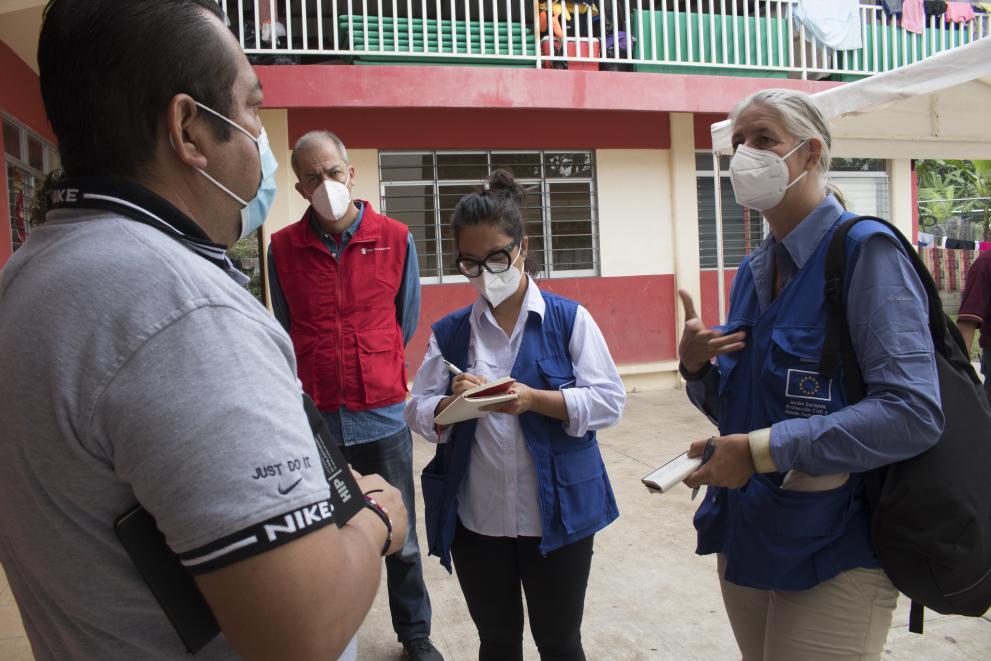What is it?
Ensuring the protection of populations is a core objective of humanitarian action. Protection is a broad concept, approached in many ways, ranging from delivering basic humanitarian assistance to deploying peacekeeping troops.
The European Commission defines humanitarian protection as addressing violence, coercion, deliberate deprivation and abuse for persons, groups, and communities in humanitarian crises. This is performed complying with humanitarian principles of humanity, neutrality, impartiality and independence, and with respect of international law.
International law defines the global framework for protecting populations: it includes international human rights law, international humanitarian law and international refugee law. This framework defines the obligations of states and warring parties to assist and protect civilians, and to prevent and refrain from behaviour that violates their rights.
Why is this important?
In humanitarian crises, people need basic assistance such as food, water, medical, and psychological assistance. But when there’s violence and hardship, they also need specific support to stay safe and keep their dignity.
Around the world, armed conflicts continue to cause high levels of civilian deaths, injury, displacement, psychological trauma, and sexual violence. Besides, increasing numbers of people are impacted by climate change, economic instability and food insecurity, among others.

Many people caught by humanitarian crises face increasingly complex “protection risks”. These include gender-based violence, restrictions to freedom of movement, theft or extortion, child marriage, or trafficking in persons.
Forced displacement, projected by UNHCR to affect more than 130 million forcibly displaced persons in 2024, presents significant protection risks for millions fleeing for safety. Certain vulnerable groups, such as children or persons with disabilities, are the ones exposed to the most disproportionate protection risks.
How are we helping?
EU-funded protection interventions aim to prevent, reduce, and respond to the risks and consequences of violence, coercion, deliberate deprivation, and abuse in humanitarian crises.
Protection is embedded in our mandate as defined by the European Council's Humanitarian Regulation (1996) and confirmed by the European Consensus on Humanitarian Aid (2007).
In May 2016, we published the staff working document ‘Humanitarian Protection: Improving protection outcomes to reduce risks for people in humanitarian crises’ which outlines the definition and objectives of the European Commission’s humanitarian protection work.
The staff working document provides guidance for (i) the analysis of protection risks, (ii) programming of protection work in humanitarian crises, (iii) measuring the effect and outcome of interventions, and (iv) capacity-building activities.
In May 2024, the Council of the European Union published the Council conclusions on protection in humanitarian settings. This significant effort seeks to unify and clarify fundamental ideas related to protection, thereby enhancing our collective comprehension of the concept. The document outlines specific, actionable steps and shared obligations that EU institutions and Member States are expected to undertake.
Humanitarian protection is both a sector and cross-cutting issue. We use 2 main approaches:
- targeted protection actions: such as (i) helping people obtain documentation or legal status; (ii) preventing and responding to violence, including gender-based violence; (iii) child protection; (iv) mine action
- protection mainstreaming: incorporating protection principles and promoting meaningful access, safety, dignity, accountability, participation and empowerment for all social groups in all humanitarian projects, regardless of the sector.
EU-funded protection initiatives
The EU allocated over €1.5 billion for protection actions from 2018-2023. These are some examples of our protection actions across the world.
In Ukraine, EU humanitarian aid provides lifesaving protection assistance, focusing on the areas most affected by the conflict. Protection assistance includes support to the most vulnerable children, persons with disabilities and older persons, especially those without family.
We also provide legal assistance, mental health and psychosocial support to internally displaced and others affected by the conflict. EU humanitarian aid also supports monitoring to identify protection trends to deliver most needed protection assistance.

Our main protection interventions in this region aim to:
- provide emergency protection assistance to the most affected women, men, girls, and boys who suffered or are at highest risk of suffering human rights violations
- promote compliance with international humanitarian law and international human rights law among weapon bearers.

In northern Mozambique, non-state armed groups continue to carry out attacks, which disrupt civilian life, cause displacement, and harm civilians and civilian infrastructure.
EU humanitarian aid provides access to protection services, including for people affected by sexual and gender-based violence and for children affected by armed conflict.

The complex mixed migration crisis remains underestimated in numbers, modalities, threats, and needs. This exacerbates risks for people on the move and puts significant pressure on existing protection services.
To enhance evidence-based programming and advocacy, EU works closely with the Global Protection Cluster.
The aim is to highlight interconnected, multi-country and multi-dimensional vulnerabilities, as well as reinforce protection preparedness and response systems across the region.

Protection is at the core of EU humanitarian interventions in the Asia-Pacific region. We focus on advocacy for international humanitarian law and international refugee law as this is often a essential to access assistance and protection.
The EU supports civil identification, protection for survivors of gender-based violence and child protection throughout the region. We also integrate protection activities into emergency response.
In addition, the EU funds explosive ordnances’ reduction and risk mitigation. We help authorities and communities to prepare for how to deal with protection in both future natural hazards and human-induced disasters.

Facts & figures
Humanitarian protection aims to prevent, reduce, and respond to the risks and consequences of violence, deprivation, and abuse in humanitarian settings.
According to the Global Protection Cluster, in 2023, over 168 million people required protection due to humanitarian crises.
The EU allocated over €1.5 billion for targeted protection actions from 2018-2023.
In 2023, nearly 10 million people benefited from EU-funded protection actions.
In the past years, on average the EU has allocated 11.5% of its global budget to protection.
Last updated: 07/06/2024

